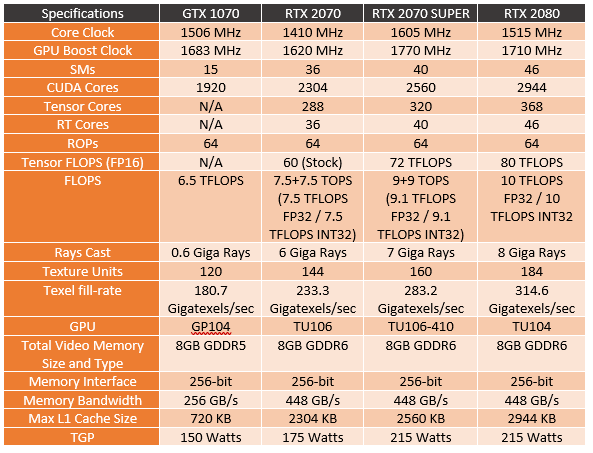I took a look at the new RTX 2060 SUPER Founders Edition first and was impressed that Nvidia basically turned it into the RTX 2070. With that in mind, it only made me wonder even more where that put the also announced RTX 2070 SUPER. So today I’m going to dive into the changes, take a look at the Founders Edition card, and then run the RTX 2070 SUPER FE through our ever-expanding benchmark suite. After that, we can take a look at pricing and see where the new card fits into the market. I don’t think I will ever get used to the SUPER branding when Nvidia had a few throwback options like GT and Ultra that they have used before. But beyond that, I’m excited to see how the 2070 SUPER performs.
Product Name: Nvidia RTX 2070 SUPER Founders Edition
Review Sample Provided by: Nvidia
Written by: Wes Compton
Pictures by: Wes Compton
Amazon Affiliate Link: HERE
SUPER? What’s changed
Normally before diving into testing a new GPU, I would want to dig into the architecture changes and see what is new but the SUPER lineup isn’t an architecture change nor is it a die shrink. But that isn’t to say that nothing has changed. I went into detail on the changes with the RTX 2060 SUPER in that review so for this review I am focusing on what has changed with the RTX 2070 SUPER. To do that in the table below I have included the GTX 1070, RTX 2070, and the RTX 2080 alongside the new card. The idea is to get an idea of how far things have come from the GTX 1070, to compare the 2070 vs the 2070 SUPER, and then to see how the new card compares to the older RTX 2080. The RTX 2060 SUPER ended up being more like a baby RTX 2070, will that happen with the 2070 SUPER as well?
So like with the 2060 SUPER Nvidia didn’t just change clock speeds they did open up addition cores on the TU106 GPU for the new SUPER model. They went from 36 SMs up to 40 which translates to a jump from 2304 to 2560 CUDA cores. This, however, doesn’t get the 2070 SUPER as close to the RTX 2080 as they did with the 2060 SUPER and the RTX 2070. Part of that is because the 2080 is actually running on a different GPU, the TU104 not the TU106 that the 2060 and 2070 shared. To help compensate they did, however, bump the clock speeds up a lot more. In fact, the 2070 SUPER is clocked higher than the RTX 2080 as well with its 1605 MHz base clock and 1770 MHz boost clock speed. That’s well above the 1410 MHz core clock of the original 2070! The clock speed change and the additional SMs did bring the TFLOP rating up from 7.5 to 9.1 on both FP32 and INT32 workloads which is closer to the 10 TFLOPS of the RTX 2080 than the 7.5 of the 2070. Memory capacity and the controller didn’t change, the RTX 2070 SUPER has the same 8GB GDDR6 and 256-bit controller that the RTX 2070 and RTX 2080 have. The increase in clock speed and core count did, however, change the TGP needed. It went from 175 watts to 215 watts which matches the RTX 2080.
I mentioned all of this in the RTX 2060 SUPER review as well, but if you missed that Nvidia’s presentation focused on a few other areas as well and I wanted to touch on a few of those. Obviously, they did put some basic information about the three new cards. The 2080 Super is faster than the Titan XP which I thought was interesting and the 2070 Super is faster than the 1080 Ti. The 2080 Super is up ahead of the GTX 2080 as well.
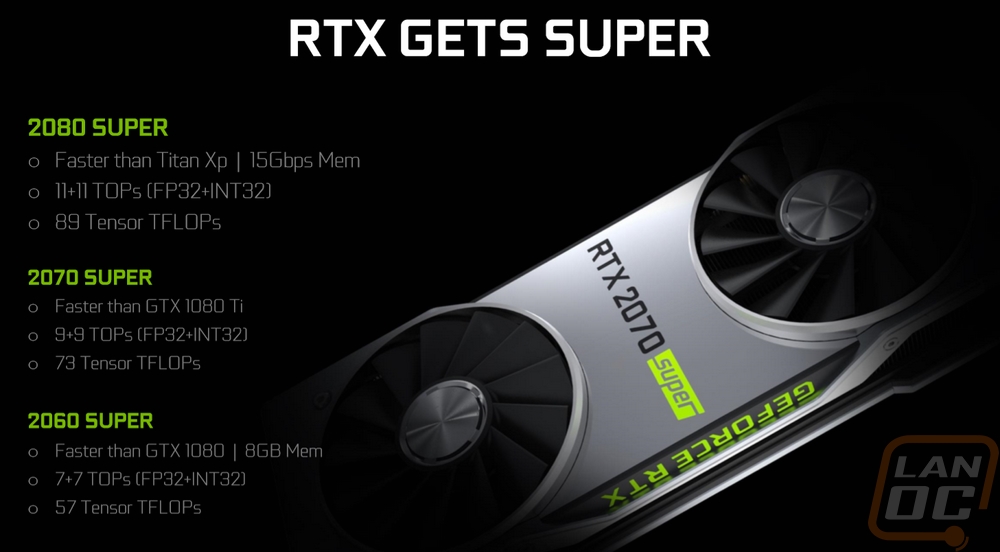
They also focused a lot on all of the big ray tracing games of E3 this year, as I mentioned at the start ray tracing is starting to take off when just 9 months ago at the RTX launch there were only a few demos that had it. Big games like Cyberpunk, Watchdogs, Doom, and Wolfenstein all will have ray tracing. Even more importantly all of the big engines and APIs are getting it as well which should translate to a lot of the smaller titles starting to introduce it as well.

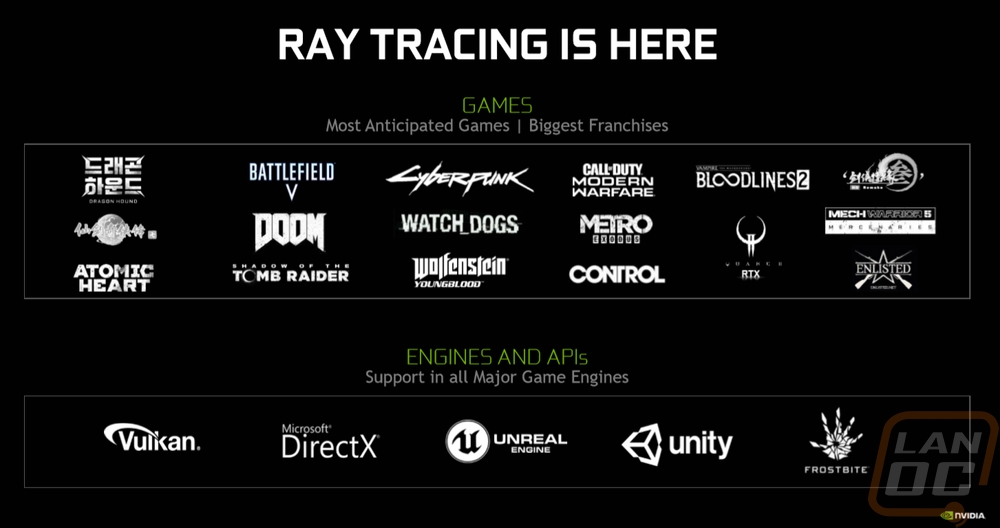
Nvidia’s other big announcement alongside the SUPER launch is a software introduction for Frame View. Frame View does a few different things. It is similar to FRAPS in that you can run benchmarks to track FPS but it allows looking at the FPS at the rendered FPS which is at the beginning at the pipeline and the displayed FPS which is at the end of the pipeline. You can also check out percentile FPS in a few different variations. You can also check out the video cards power usage with GPU only or TGP power usage. That right now is only supported by Nvidia cards. All of this can be outputted to excel files and also put on an on-screen overlay. The scan files can get really interesting when putting the frame rate information together with the power usage numbers. You can chart performance per watt graphs. I had a bit of a late start on my testing so I haven’t had the chance to play with Frame View too much but it could be very interesting for testing!
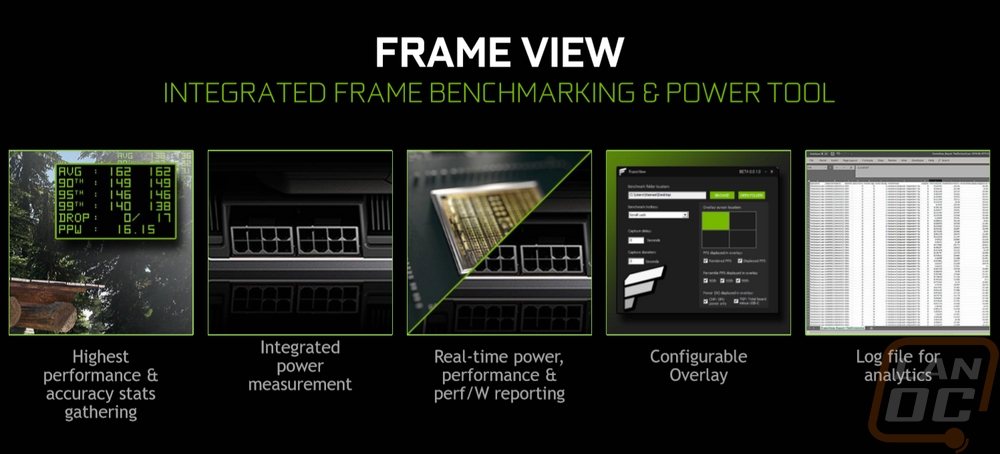
Before getting into testing I also took a look at GPUz to confirm that our test card was running at the same clock speed as listed in the specifications. This also lets me document what vBIOS our card is running and the driver used for testing (the pre-launch press driver).
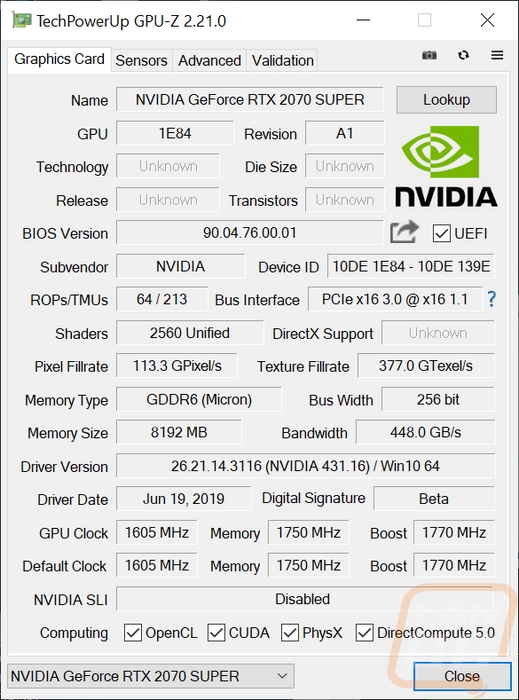
Nvidia also released a hype video for the new SUPER lineup with a SUPER hero feel this morning. You can check that out here as well.
Packaging
A lot of times launch samples or reference cards don’t come with any packaging. But with Nvidia moving to selling some of their Founders Edition cards a few years ago one of the bonuses of that was the move to having proper packaging for the cards. The SUPER cards didn’t change anything here. They have that same trippy stripped box design as the other RTX cards and the RTX wrap around that all Nvidia cards have is there. Down on the bottom and on the end of the box the model number is still there only this time it has that SUPER logo.


Inside the box, I do still love how when you get these you open the box up to find the card sitting there like a jewel for you. Nvidia even goes out of the way to use a clear plastic on the card itself so you can see it. There is also the pull out tray tucked in behind the card. Inside it has the quick start guide and a support guide. The quick start guide is card specific with the 2070 SUPER branding on it. Also with the documentation, Nvidia included one of their DisplayPort to DVI adapters for anyone who still needs DVI.


Card Layout and Photos
Well if you remember the RTX 2070 Founders Edition this RTX 2070 SUPER is actually a big change from the original. Were the 2060 SUPER only added the chrome but kept the size and cooler on the card the same. For the RTX 2070 SUPER, they moved from the same size as the 2060 up to the size and cooler used on the RTX 2080 and RTX 2080 Ti. They did still include the chrome in between the fans, but because of the size difference, it is a larger chromed out section. You still have the RTX 2070 branding as well as that bright green SUPER logo as well. The dual fan configuration isn’t any different than the smaller cards, the fans are the same size and have the same blade count and angle. They also still have those machined aluminum caps on the fan centers as well.



Up on the top edge of the 2070 SUPER, you have the same GeForce RTX logo which looks chrome when not lit up but is backlit in Nvidia’s green. I’ll say it again, like I always do I love the green but please please give everyone the option to change this. At least the chromed look when off looks good and doesn’t force the green on you even without the lights like the older blower cooler did. The top edge has a little more of the traditional Nvidia styling with the silver band that wraps around the top logo, this same styling cue was on the last two cooler designs. You can see that unlike the previous 2070 the 2070 SUPER does have an NVLink bridge. The card ships with a nice metal cover over it but the move to the RTX 2080 size also adds support for dual cards. Also up on the top, as it should be, are the power connections. The single 8-pin of the original 2070 is now an 8-pin and a 6-pin to support that bump up in TGP. Unlike some of the aftermarket cards, Nvidia has to keep these connections flipped around the normal direction because of the backplate so you can see how the heatsink is notched around that area to leave room to unplug.



Speaking of the heatsink, just like on the 2060 SUPER you can spot those great looking black fins from the top and bottom of the card. The dual axial fan design that they moved to with the RTX cards mean air blow down through eh heatsink towards the PCB and then has to vent out the top and bottom of the card. The old blower design was sealed and would pull air in from inside of the case but blow it out the PCI bracket area. This design does have some ventilation at the PCI bracket but most of the air is going out the top and bottom.


Because the power connection is up to like a normal card the end of the 2070 SUPER is a lot more boring than the 2060 SUPER. You have the Nvidia logo in the all-metal shroud. Beyond that, the backplate and the front shroud both wrap around on the end here to seal the end up. It does still have the two mounting screw holes for server and OEM sagging support, something none of the aftermarket cards bother to include.


The backplate has the same thick material that the rest of the card is made of which is one of the big reasons the Founders Editions feel so solid when you hold them in hand. You can get another look at that NVLink connection cover up on the top edge, it matches the backplate really well. For styling, they did carve small lines into the backplate that move around the logo in the middle. The logo is flipped so you can read it when installed in a case and has that chrome finish with the bright green SUPER logo. Even beyond being a little unsure about the SUPER branding as a whole, I think I would prefer the branding be anything but that bright green, but it does look good with the silver at least.

So the older RTX 2070 still had the DVI connection like the RTX 2060 SUPER has but when moving to the RTX 2080 configuration it also drops the DVI connection and adds another DisplayPort in its spot. That gives you a total of three DisplayPort connections, one HDMI, and the small USB Type-C with VirtualLink support. VirtualLink combines display, power, and USB to give you a single plug VR connection. Right now you have to use a box to hook everything into with a mess of wires. There is a small Nvidia logo here on the all back PCI bracket which is a small detail but looks awesome installed.

I did have our RTX 2070 Founders Edition card out next to the RTX 2070 SUPER Founders Edition and it really shows the differences in the cooler design and card size.


I did get a few pictures of the card with the top logo lighting on and examples of how the chrome will handle other RGB lighting in your case. Surprise surprise, chrome reflects everything. So motherboard lighting for example or anything below your video card is going to reflect off of it.
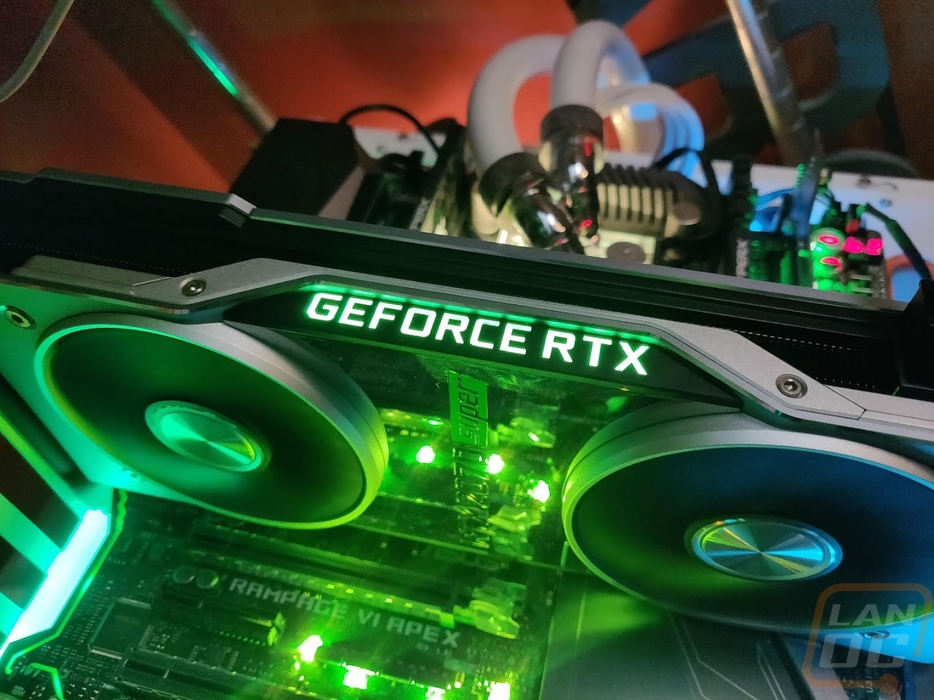
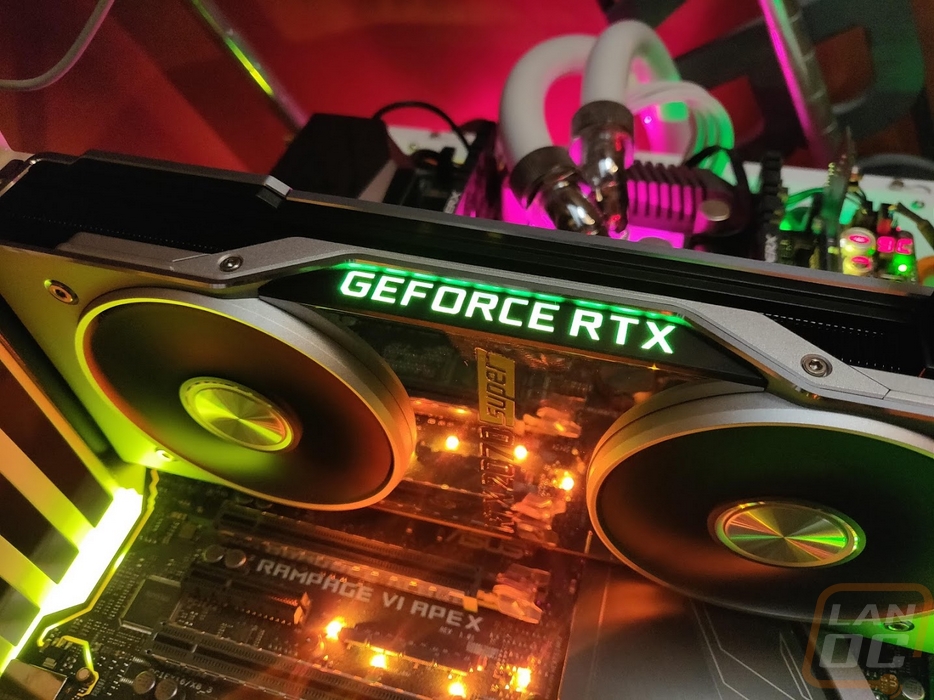
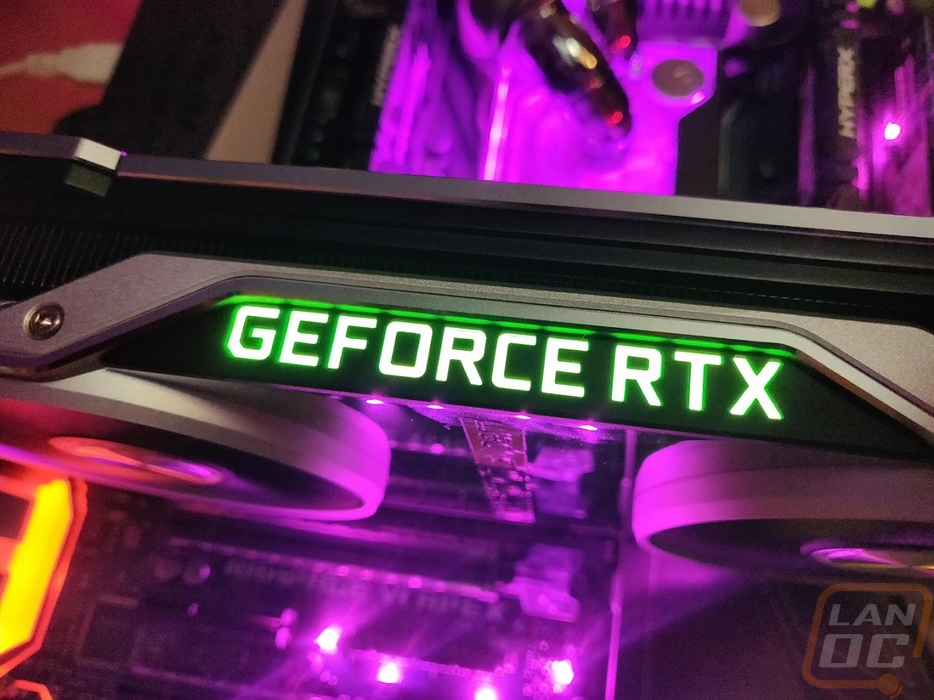
Test Rig and Procedures
Our Test Rig Configuration (with affiliate links)
CPU - Intel i9-7960X
Motherboard - Asus ROG Rampage VI Apex
Memory - HyperX DDR4 Predator 3000MHz
Storage - Kingston A1000 960GB M.2 SSD
Cooling - Noctua NH-U12S
Power Supply - Corsair AX1200w
Case - Primochill Wetbench

Synthetic Benchmarks
To start off my testing I always like to work with a few synthetic benchmarks. They don’t translate directly to in game performance numbers but they are consistent and both AMD and Nvidia optimize for them meaning they give you a good look at what you should expect performance wise. Especially when comparing from card to card which in this case is exactly what we want to see. I’m really curious how the RTX 2070 SUPER compares with the old RTX 2070 model as well as the RTX 2080. Nvidia didn’t give the 2070 SUPER as big of a CUDA core bump as the 2060 SUPER received, but it will be interesting to see how the bump they did give along with the big jump in clock speed as well.
To start off my tests I went with the older 3DMark Fire Strike benchmark in all three detail/resolution variations. These are DX11 based tests which give us a look at older game performance. All three has basically the same order putting the RTX 2070 SUPER FE ahead of the Vega 64 Liquid Cooled. He 2070 SUPER lands right in the middle of the original 2070 and the RTX 2080.



Now the Turing based video cards really like the DX12 based tests and games and this showed on the two 3DMark Time Spy tests. Here the 2070 SUPER is up closer to the RTX 2080. This was also enough to jump out ahead of the GTX 1080 Ti and the RX 590s in Crossfire by a good margin as well.


With ray tracing starting to pick up I have been keeping an eye on the performance with 3DMark’s Port Royal benchmark. In this test, the 2070 SUPER is right up with the RTX 2080 and well ahead of the 2060 SUPER and the RTX 2070. Real-time ray tracing is extremely demanding so getting the best possible performance here is going to help a lot with performance in future games.

Beyond the 3DMark tests, I also tested with the Unigine Engine based Superposition benchmark. I tested at 1080p at medium and extreme detail settings and then at 4k and 8k for the ultra high resolutions. The RTX 2070 SUPER jumped WAY out ahead of the RTX 2070 and the GTX 1080 with 11Gbps memory in all of these tests, especially the extreme detail test.

VR Benchmarks
I love VR gaming but it is more demanding than traditional games because of the frame rate that is required for things to feel smooth. To test this there aren’t enough tests that you the reader can also run for comparison so I only have the SteamVR benchmark and VRMark to test with. Hopefully, we see more options soon. The SteamVR test is dated and was just a simple test to make sure a video card can handle the basic VR experience, all of the RTX cards have maxed out this result so there isn’t much to learn from that test.

The VRMark test, on the other hand, lets us look at a few aspects. So orange room is a lower end test similar to the SteamVR test which shows current day basic game performance, blue room is future looking for much more demanding games, and cyan fits in the middle with demanding current day VR game performance. The orange room results are basically off the charts so there isn’t any point in worrying about those. Blue room, well none of the cards have reached the FPS target on it but you can see that the RTX 2070 SUPER FE is right up at the top with just the RTX 2080 cards and the RTX 2080 Ti being quicker. This was a big jump over the GTX 1080 Ti and the original RTX 2070. The Cyan results are getting close to being like the orange room results with nearly every card I’ve tested coming in ahead of the target FPS but at 233.45 FPS the 2070 SUPER isn’t going to have any trouble with any of today's VR titles.

In-Game Benchmarks
Now we finally get into the in game performance and that is the main reason people pick up a new video card. To test things out I ran through our new benchmark suite that tests 16 games at three different resolutions (1080p, 1440p, and 4k). I also slipped in a few variations on the same games for comparisons like DX11 to DX12, OpenGL to Vulkan, and a couple of games are just tested at their highest setting and lower but still high detail options to show the performance difference when things are turned down slightly. In total, each video card is tested 75 times and that makes for a huge mess of graphs when you put them all together. To help with that I like to start off with these overall playability graphs that take all of the results and give an easier to read the result. I have one for each of the three resolutions and each is broken up into four FPS ranges. Under 30 FPS is considered unplayable, over 30 is playable but not ideal, over 60 is the sweet spot, and then over 120 FPS is for high refresh rate monitors. This covers all of the games tested except Final Fantasy XV that we have a score rather than an FPS because they like to be different.
So how did the RTX 2070 SUPER Founders Edition perform? Well, 1080p performance wasn’t an issue at all, the 2070 SUPER ripped through all of those games with 10 games up over 120 FPS as well and not even one under 60 FPS. 1440p is nearly the same with 18 games in the 60-119 FPS range and another even higher up above 120 that left just three games at 1440p that were below 60 FPS at all. Two of those were our newest additions at their highest detail settings (Metro Exodus and Total War: Three Kingdoms) and the last was Ghost Recon Wildlands at its ultra detail. All of those were in the 56 FPS range so while not above 60 FPS, still very close. Then at 4k we finally see a game down below 30 FPS and a majority of the games below 60. You could play at 4k, but it is going to require turning the detail a little if you want the smoother 60+ FPS or you will have to live in that 30-60 FPS range at high detail settings. All in all, the RTX 2070 SUPER is a monster at 1080p, great at 1440p, and could get you by at 4k.



I did also test using Final Fantasy XV which doesn’t give us FPS results so they are kept split up from the other games. Here the 1080 Ti still outperformed the RTX 2070 SUPER but only by a very small margin. This was still a good jump up from even the overclocked RTX 2070s, but the 2080 is still well ahead in this test. The same can’t be said on the DLSS vs TAA test, with the detail turned all the way up the RTX 2080 and RTX 2070 SUPER even out. The importance of that test, however, is to show how using DLSS with the Tensor cores can boost performance up significantly at otherwise the same detail. This, like ray tracing, is still making its way into more games. But it uses AI to predict the “perfect frame” and to get higher detail without having to render at as high of a resolution.


As always I have all of the detailed graphs as well for the crazy people like myself. 24 different tests, all run at three different resolutions across 10-27 cards, that is a lot of data! So here I want to see where the RTX 2070 SUPER FE comes in comparison to other cards. I also want to look for any weird results. In most of the tests the RTX 2070 SUPER came in just a little behind the RTX 2080, there were a few tests were the higher clock speeds helped and it did outperform the older RTX 2080 FE but only by a small margin like in the DOOM Vulkan test, Hitman DX 11, and Far Cry 5 with normal detail. The 2070 SUPER really is no longer in the same class as the original RTX 2070, even the overclocked cards were still down in performance compared to it. The GTX 1080 Ti does slip in a few tests faster, as does the Vega 64 but as a whole, it is the 2080 Ti, 2080, 2070 SUPER, then everything else. Games like F1 2017 which are a little less demanding just like today's esports titles like LoL, DOTA 2, and CS:GO were all nearing the 200 FPS range at 1080p and would also support high refresh rates at 1440p as well. The difference between DX11 and DX12 in Hitman was 20 FPS at 1080p, 10 at 1440p, but then at 4k, they evened out. OpenGL to Vulkan also had around a 30 FPS jump but at all resolutions.
























Compute Benchmarks
Now some people do use their video cards for other uses like streaming, video production, and 3D modeling. With all of those compute performance is important. To check to see how the RTX 2070 SUPER FE can handle those loads I ran through a few different tests. The first was the GPU Compute test inside of Passmark’s Performance Test 9. Here the 2070 SUPER falls right in between the old 2070 and the old 2080. The older GTX 1000 series cards did still handle this test a little better with the older 1070 Ti basically matching the 2070 SUPER.

Now the Blender benchmark is an important one because it is one of the most popular 3D rendering programs and it is free. In this test, the high clock speeds of the 2070 SUPER did really well, even outperforming the RTX 2080.

In the two Basemark GPU tests again the RTX 2070 SUPER edges out ahead of the RTX 2080 which is impressive.

In Geekbench 4 the RTX 2080 pulled back ahead with the 2070 SUPER being about halfway between the 2080 and the overclocked 2070s.

Cooling, Noise, and Power
While gaming and compute performance are the most important when picking which GPU you want to go with. Once you decide on a GPU the cooling, noise, and power all are important when deciding which card you want. They are what set different models from the same AICs apart along with relatively small overclocks. Power, for example, determines how big of a power supply you might need, not to mention power usage over years of gaming. For testing that I hooked our entire test system up to a Kill-A-Watt and monitored the max wattage pulled when under load. For load, I did two different tests. One with 3DMark Fire Strike on the combined run which loads the video card and the CPU similar to a normal game and the second test with AIDA64’s stress test loading the video card. With 3DMark the 2070 SUPER pulled 425 watts which was just below the RTX 2080 with a similar configuration and 32 watts more than the original RTX 2070 FE. With AIDA64 the total wattage pulled is less without the CPU being added in, but it does put the video card under a little more stable of a load. Here the 2070 SUPER pulled 280 watts, 10 watts more than the RTX 2070 FE.


Next, I took a look at fan noise. For this I did three tests, two by hard locking the fan speeds to 50% and 100% and measuring the noise output from 18 inches away. The third I did the same measurement but from when I was doing thermal testing and had the card under a constant load for a half hour with the stock fan profile. That third test gives us a look at what you should expect for noise with the card at its hottest. So for noise the 2070 SUPER was in line with the other RTX cards at 60.1 decibels at 100 percent fan speed. This isn’t a big shock considering they all have the same fans. This is an improvement over the older 1080 Ti which ran its single blower fan at a higher RPM but it is actually louder than the other blower cards and frankly WAY off from what the aftermarket cards do. The 2070 SUPER was even louder than the 2060 SUPER in the stock profile load test which like I mentioned before is really the main number you want to know. Overall this is the one area that the RTX Founders Edition cards are weak in compared to the aftermarket variations.


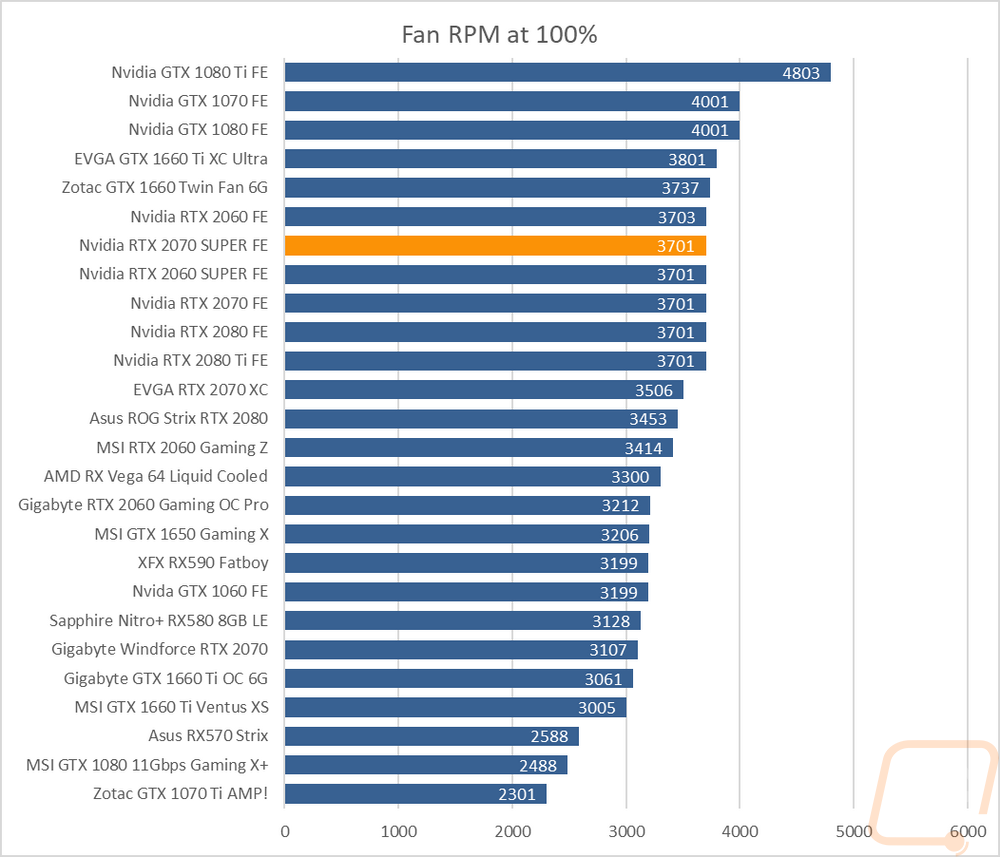
As for temperatures, for these tests, I put the RTX 2070 SUPER under load using AIDA64’s stress test and let it go until the temperature leveled off with a minimum of a 30 minute load time. I did this twice, once with the stock fan profile and then again with the fan turned all the way up. I wanted to see what you should expect out of the box and then what the cooler is capable of. The delta between those two also shows us how much cooling headroom the cooler has. So with the stock profile, the 2070 SUPER reached 62 degrees Celsius. This oddly enough was better than the RTX 2080 and the original RTX 2070 as well. Of course, that model was using a smaller heatsink. With the fan turned up to 100% that dropped down to 48 which was higher than the RTX 2080 showing that the fan profile has potentially changed a little with the new cards. A 14-degree delta between the two isn’t bad though I bet a lot of the aftermarket cards edge out a little better.

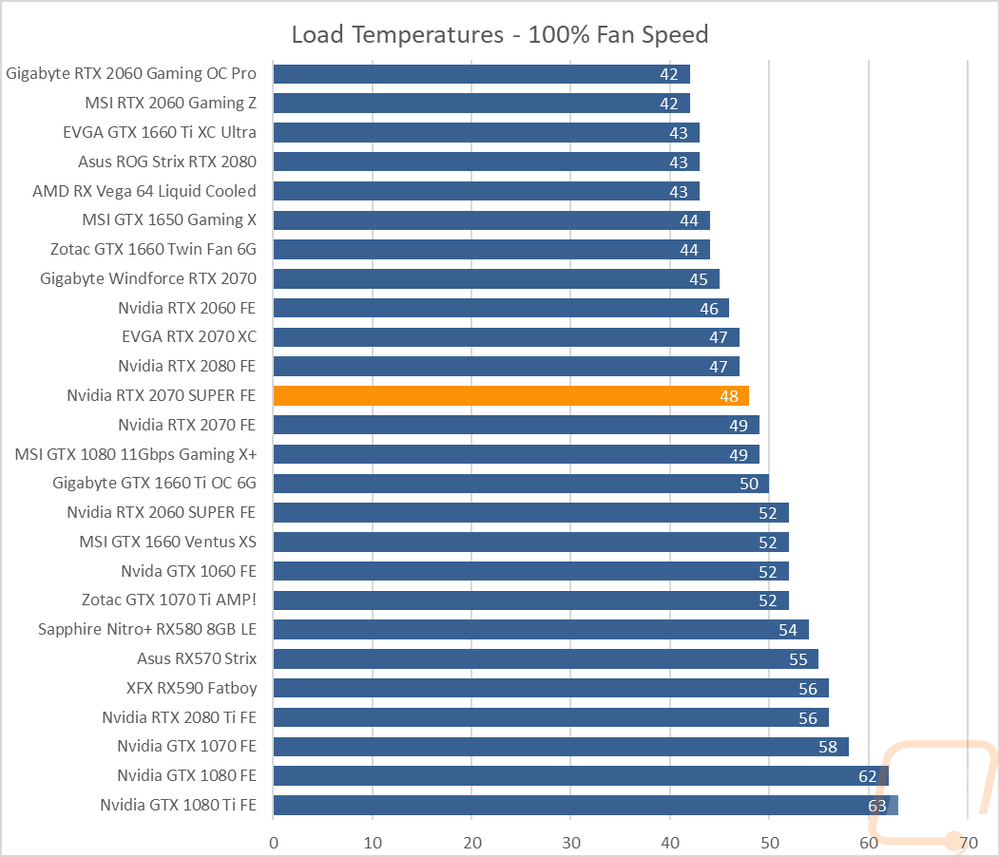
While doing the temperature testing I did also bring out the thermal camera to take a look at the 2070 SUPER after it had been under load for a while. I noticed that it has the same hot and cool spots behind the fans as the RTX 2060 SUPER did. The hotspot on the back of the card is larger and more noticeable as well but you can see the backplate pulling some of that heat out across it. Then the top down look shows the hottest area on the card by far is the center at the top where most of the airflow is coming out. There is also heat going out the bottom heating up that PCI slot, I wouldn’t put one of these Founders Edition cards right above an M.2 slot but it isn’t bad enough to be a concern otherwise.



Overall and Final Verdict
After checking out the RTX 2060 SUPER FE and seeing that it is basically a baby RTX 2070 I couldn’t wait to see what the RTX 2070 SUPER FE had going on. Nvidia gave it four additional SMs which in itself is a performance bump but then on top of that the 2070 SUPER also saw a big jump in both core clock and boost clock speeds. To go with that it moved from the PCB/cooler that the RTX 2060 and RTX 2070 used up to the same setup as the RTX 2080 including even adding multi-GPU back with NVLink support. Like with the 2060 SUPER this pushed the 2070 SUPER’s performance up closer to the RTX 2080 than the RTX 2070. This is the baby RTX 2080 now. 1080p performance is off the charts and perfect for someone who wants to game with a high refresh rate monitor even with some of today's newest games at their highest settings. 1440p is where it's at though everything is going to be playable with 21 out of 24 tests coming in at 60 FPS or much higher.
Like all of the other Founder Edition cards, the RTX 2070 SUPER Founders Edition stands out against all of the aftermarket cards with its all-metal cooler design. Even the cards that are using metal fan shrouds and backplates aren’t using cast parts like this and the Founders Edition feels so solid. Most aftermarket cards get a little GPU sag over time, even with a backplate, but I can’t imagine that happening with any of the Founders Edition cards. Visually the 2070 SUPER FE is different than everything else on the market, especially with everything being decked out in silver. If that wasn’t enough the addition of chrome to the design is surely going to be even more polarizing. It looks amazing in pictures and on our test bench, but if you want a blacked out build this is as far from that as you can get. Speaking of matching things with your build, Nvidia still has the top logo stuck in the bright green mode with no RGB option, the green looks good with the silver and chrome but I know I’m not the only one who wants to be able to set that to match my build. The only other issue is that the cooler, like the other RTX cards, is a little loud.
As far as pricing goes, the new RTX 2070 SUPER Founders Edition is listed at $499. Considering that performance is edging up closer to the RTX 2080 and the price is the same as the current RTX 2070 it seems to be a good value. With AMD launching a new card soon it will be very interesting to see how things compare. Right now Nvidia has a bundle to go with the RTX 2070 SUPER as well which gets you Control and Wolfenstein: Youngblood, two titles which are both slated to support ray tracing. Wolfenstein: Youngblood is coming out late in July and Control in August giving you time to enjoy both. I’m loving that both Nvidia and AMD have been partnering up with launch day bundles, new titles add a lot more value than older games, especially when they help you take advantage of the ray tracing support. Now I wouldn’t consider the RTX 2070 SUPER a value card unless you are looking to game at 1440p. While the RTX 2060 looks to be staying in Nvidia’s lineup at $349, the RTX 2070 and RTX 2080 weren’t listed in Nvidia’s current lineup/pricing information, but it makes sense as the RTX 2070 is nearly passed up by the RTX 2060 SUPER at a better price and the RTX 2080 isn’t that far ahead of the 2070 SUPER making them a little unneeded in the lineup. It will be interesting to see how pricing on those cards change if they are being phased out. But as of right now at least, in the $500 range you aren’t getting better than the RTX 2070 SUPER for a new card.


Live Pricing: HERE


